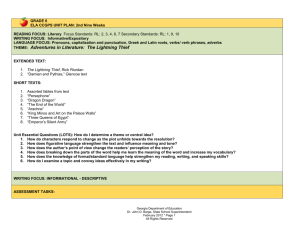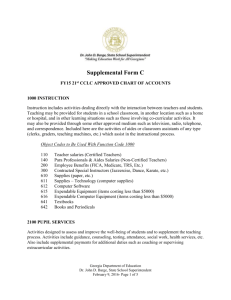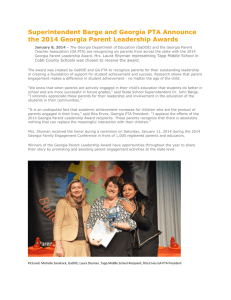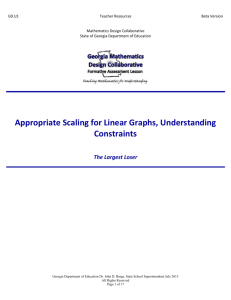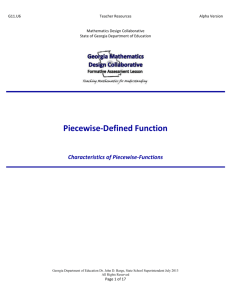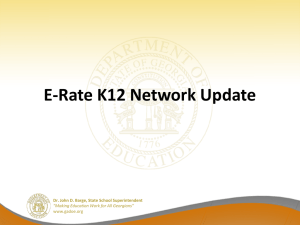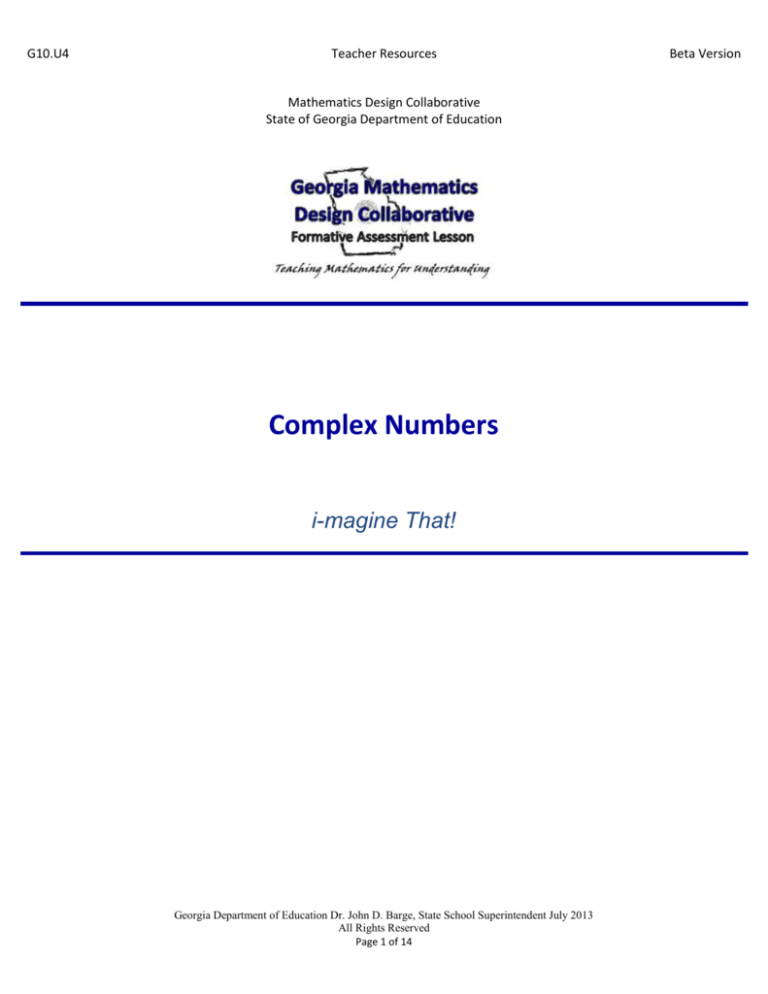
G10.U4
Teacher Resources
Mathematics Design Collaborative
State of Georgia Department of Education
Complex Numbers
i-magine That!
Georgia Department of Education Dr. John D. Barge, State School Superintendent July 2013
All Rights Reserved
Page 1 of 14
Beta Version
G10.U4
Teacher Resources
Beta Version
INTRODUCTION TO THIS FORMATIVE ASSESSMENT LESSON
MATHEMATICAL GOALS
This lesson unit is intended to help you assess how well students are able to:
Perform arithmetic operations with complex numbers.
To use the relation i2 = -1 to simplify complex numbers.
GEORGIA STANDARDS OF EXCELLENCE
This lesson involves mathematical content in the standards from across the grades, with emphasis on:
MGSE9-12.N.CN.1 Understand there is a complex number i such that i2 = −1, and every complex number has
the form a + bi where a and b are real numbers.
MGSE9-12.N.CN.2 Use the relation i2 = –1 and the commutative, associative, and distributive properties to add,
subtract, and multiply complex numbers.
This lesson involves a range of mathematical practices, with emphasis on:
SMP 6. Attend to precision.
SMP 8. Look for and express regularity in repeated reasoning.
INTRODUCTION
This lesson is structured in the following way:
Before the Lesson,
Students work individually on an assessment task that is designed to reveal their current understandings and
difficulties. You then review their work, and create questions for students to answer in order to improve their
solutions.
At the Start of the Lesson,
After a whole-class interactive introduction, students work in pairs on a collaborative discussion task in which
students will choose complex expressions that yield the given solution. Periodically walk around the room checking
students work. If help is needed, only a minimal amount of help should be offered.
After the Whole-Group Class Discussion,
Students return to their original assessment tasks, and try to improve their own responses.
Georgia Department of Education Dr. John D. Barge, State School Superintendent July 2013
All Rights Reserved
Page 2 of 14
G10.U4
Teacher Resources
Beta Version
MATERIALS REQUIRED
Each individual student will need:
Two copies of the Formative Assessment Complex Numbers for Pre-Assessment and for
Post-Assessment
A mini-whiteboard, pen, and eraser
Each small group of students will need:
A set of complex equation card
A set of complex expression cards
Poster paper or construction paper
Glue sticks or tape
There are also some slides to help with instructions and to support whole-class discussion.
TEACHER PREP REQUIRED
Teacher, be advised that prior to the lesson, the following preparations/copies will need to be made:
Enough copies of the Pre-Assessment for each student
Enough copies of collaborative activity (whole group) for each student
Enough copies of collaborative activity (cards already cut) for each GROUP
TIME NEEDED:
For Pre-Assessment:
15 min
For Lesson:
55 min
For Post:
15 min
FRAMING FOR THE TEACHER:
This FAL is important because it addresses the standards of complex numbers. It helps the students’ master adding,
subtracting, and multiplying complex numbers so higher order questions are possible without the computational
aspect hindering understanding. Complex numbers are necessary for understanding calculus.
FRAMING FOR THE STUDENTS:
Say to the students:
This activity will take about 1.5 days for us to complete.
The reason we are doing this is to be sure that you understand how to solve complex numbers before we move on to a
new idea.
You will have a chance to work with a partner to correct any misconceptions that you may have. After the partner
work, you will be able to show me what you have learned!
Georgia Department of Education Dr. John D. Barge, State School Superintendent July 2013
All Rights Reserved
Page 3 of 14
G10.U4
Teacher Resources
Beta Version
PRE-ASSESSMENT BEFORE THE LESSON
ASSESSMENT TASK:
Name of Assessment Task: Imagine That
Time This Should Take: 15 min
Have the students do this task in class or for homework, a day or more before the formative assessment lesson. This
will give you an opportunity to assess the work, and to find out the kinds of difficulties students have with it. You
will them be able to target your help more effectively in the followup lesson.
Give each student a copy of the Pre-Assessment:
Briefly introduce the task and help the class to understand the
problem and its context.
For the last week, you have been studying operations on complex
numbers. Today you will be starting a formative assessment
lesson which will help me gauge your level of understanding.
First, you will do a pre-assessment that will take 10 to 15 minutes.
The pre-assessment will uncover any gaps or misconceptions that
you still have. I will collect them and write questions that we will
discuss as a whole class tomorrow.
Tomorrow you will be working with a partner on an activity that
will help to fill the gaps the pre-assessment revealed. The activity
will take most of the period. After completing the activity we will
come back together for a whole class plenary discussion to
address lingering questions.
Finally, you will be given a post-assessment much like the pre-assessment which will give you the chance to
demonstrate the progress you’ve made and have 100% success.
Students should do their best to answer these questions, without teacher assistance. It is important that students are
allowed to answer the questions on their own so that the results show what students truly do not understand.
Students should not worry too much if they cannot understand or do everything on the pre-assessment, because in the
next lesson they will engage in a task which is designed to help them. Explain to students that by the end of the next
lesson, they should expect to be able to answer questions such as these confidently.
This is their goal.
Georgia Department of Education Dr. John D. Barge, State School Superintendent July 2013
All Rights Reserved
Page 4 of 14
G10.U4
Teacher Resources
Beta Version
COLLABORATION TIME/READING STUDENTS RESPONSES
You Will Not “Grade” These!
Collect students’ responses to the task. It is helpful to read students’ responses with colleagues who are also analyzing
student work. Make notes (on your own paper, not on their pre-assessment) about what their work reveals about their
current levels of understanding, and their approaches to the task. You will find that the misconceptions reveal
themselves and often take similar paths from one student to another and even from one teacher to another. Some
misconceptions seem to arise very organically in students’ thinking. Pair students in the same classes with other
students who have similar misconceptions. This will help you to address the issues in fewer steps, since they’ll be
together. (Note: pairs are better than larger groups for FAL’s because both must participate in order to discuss!)
You will begin to construct Socrates-style questions to try and elicit understanding from students. We suggest you
write a list of your own questions; however some guiding questions and prompts are also listed below as a jumpingoff point.
GUIDING QUESTIONS
COMMON ISSUES
Student Was Unable to Begin Assessment
SUGGESTED QUESTIONS AND PROMPTS
How do you add like terms?
Can you add 2x and 3y?
How do you multiply two binomials using the
distributive property?
Student failed to change i2 to -1.
What does i represent?
What is i times i?
What is i2 equal to?
Student does not distribute on problem 1d.
Student is not able to correct David’s mistakes.
How do you multiply (3 +2x)(4-5x)?
How do we use the distributive property on problems
like (3+2x) (4-5x)?
How would YOU work each of the problems?
How does your answer compare to David’s?
Georgia Department of Education Dr. John D. Barge, State School Superintendent July 2013
All Rights Reserved
Page 5 of 14
G10.U4
Teacher Resources
LESSON DAY
SUGGESTED LESSON OUTLINE:
Part 1: Whole-Class Introduction:
Time to Allot: ( 10 minutes)
Georgia Department of Education Dr. John D. Barge, State School Superintendent July 2013
All Rights Reserved
Page 6 of 14
Beta Version
G10.U4
Teacher Resources
Beta Version
Questions/Notes for discussion
Have a student share one of his/her solutions. Ask students what operation they think has been performed?
Remind students the properties of adding like terms (3x + 2x = 5x because you only add the coefficients).
How do you multiply binomials?
How can you rewrite a problem like (6+2i) – (5-3i) without parentheses? (Students often forget to distribute the
negative)
How do you simplify i2?
Part 2: Collaborative Activity:
Time to Allot: ( 25 minutes)
Georgia Department of Education Dr. John D. Barge, State School Superintendent July 2013
All Rights Reserved
Page 7 of 14
G10.U4
Teacher Resources
Beta Version
Make a note of student approaches to the task.
Listen and watch students carefully. Note different student approaches to the task and any common mistakes. For example,
Student may use the wrong operation.
Students fail to correctly add or subtract like terms.
Students fail to distribute the negative to both terms when subtracting binomials.
Students fail to use the distributive property correctly when multiplying binomials.
You can use this information to focus a plenary whole-class discussion.
Support student reasoning
Try not to make suggestions that steer students towards a particular “correct” answer or response. Instead, ask questions to
help students to reason together.
If you find one student has produced a correct response, challenge another student in the group to provide an explanation.
Example:
Sarah, how do you think Dalton arrived at his answer?
If Madelyn worked this problem (2-5i) – (-4 + 6i) and got 6 + I as her solution, would you say that she is correct? If incorrect,
can you find her mistake?
If you find students have difficulty articulating their decisions, se the sheet Suggested Questions and Prompts to support your
own questioning of students.
If the whole class is struggling on the same issue, you could write a couple of questions on the board and hold an interim,
whole-class discussion. You could ask students who performed well in the assessment to help struggling students.
Part 3 Collaborative Activity: Sharing or Presenting
Time to Allot: ( 20 minutes)
Whole-class discussion: Operations on Complex Numbers (15 minutes)
Bring the class together and use the following to guide discussion:
Students will present their poster.
How can you be sure you expressions are correct for the complex equation?
Could any of the complex expressions be added or multiplied differently but get the same complex equation?
For example, Set 1 “a” could be 3 + 5i or 6 – 8i.
What property is it called when a + b = b + a or (m)(n) = (n)(m)? Does that property work for complex
expressions?
For sets 4 and 5, what operation did you do first?
Georgia Department of Education Dr. John D. Barge, State School Superintendent July 2013
All Rights Reserved
Page 8 of 14
G10.U4
Teacher Resources
Part 4: Improving Solutions to the Assessment Task
Beta Version
Time to Allot: ( 20 minutes)
Georgia Department of Education Dr. John D. Barge, State School Superintendent July 2013
All Rights Reserved
Page 9 of 14
G10.U4
Teacher Resources – Answer Documents
PRE-ASSESSMENT (Answer Key)
Collaborative Activity Whole group intro (Answer Key)
Collaborative Activity Card set (Answer Key)
Georgia Department of Education Dr. John D. Barge, State School Superintendent July 2013
All Rights Reserved
Page 10 of 14
Beta Version
G10.U4
Student Resources
PRE-ASSESSMENT
Georgia Department of Education Dr. John D. Barge, State School Superintendent July 2013
All Rights Reserved
Page 11 of 14
Beta Version
Grade/Unit
Projector Resources
COLLABORATIVE ACTIVITY
Georgia Department of Education Dr. John D. Barge, State School Superintendent July 2013
All Rights Reserved
Page 12 of 14
Beta Version
Grade/Unit
Projector Resources
Georgia Department of Education Dr. John D. Barge, State School Superintendent July 2013
All Rights Reserved
Page 13 of 14
Beta Version
Grade/Unit
Projector Resources
Georgia Department of Education Dr. John D. Barge, State School Superintendent July 2013
All Rights Reserved
Page 14 of 14
Beta Version

